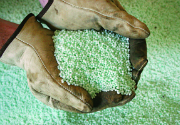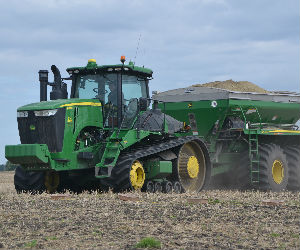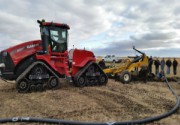| |
 |
| |
 |
|
MMMM d, yyyy |
|
| |
 The projects focus on issues such as: developing more clubroot resistant canola varieties; improve Fusarium head blight resistance in durum wheat; better control of root rot in pea and lentil crops; and increasing the use of fababeans in pet food and fish feed to create another value-added use.
» Read more...
The projects focus on issues such as: developing more clubroot resistant canola varieties; improve Fusarium head blight resistance in durum wheat; better control of root rot in pea and lentil crops; and increasing the use of fababeans in pet food and fish feed to create another value-added use.
» Read more...
Canadian National Railway Co. will buy 200 locomotives in the next three years from General Electric Co. to support expected growth and drive efficiencies.
» Read more...
After 32 years of representing the interests of all agricultural and industrial flax interests, the Flax Council of Canada’s executive committee regrets to announce the closure of its Winnipeg, Man., office.
» Read more...
|
| |
 |
| |
|
| |

For the cleanest start possible in cereals, start with a Dow AgroSciences pre-seed herbicide. We offer four options for superior pre-seed weed control that are better than glyphosate alone.
SoilActive™ technology extends broadleaf weed control, so you control the weeds you see and the weeds you don’t. Spray up to two weeks before seeding and rest easy, knowing you’ll seed into clean fields.
Get better control than glyphosate alone on winter annuals, flushing weeds and volunteer canola, including all herbicide-tolerant canola varieties.
See retailer to purchase. To find out which product is right for you, visit leavenothingbehind.ca.
>> Learn more |
| |
|
| |
 ESN is unique because it is the ONLY controlled-release fertilizer available for broad acre farming. It normally releases over a period of about 50-80 days depending on soil temperature. ESN provides long-lasting protection, better performance, greater benefits and greater value than other enhanced efficiency fertilizer options.
» Discover the truth behind the rest of the nitrogen myths.
ESN is unique because it is the ONLY controlled-release fertilizer available for broad acre farming. It normally releases over a period of about 50-80 days depending on soil temperature. ESN provides long-lasting protection, better performance, greater benefits and greater value than other enhanced efficiency fertilizer options.
» Discover the truth behind the rest of the nitrogen myths. |
| |
 ESN will in fact release in very dry soil. Lab studies have shown that soil moisture does not slow the ESN diffusion process until soil moisture dries to about 20-30% of field capacity. Once moisture is reintroduced, the process will begin again, releasing nitrogen back into the soil.
» Discover the truth behind the rest of the nitrogen myths.
ESN will in fact release in very dry soil. Lab studies have shown that soil moisture does not slow the ESN diffusion process until soil moisture dries to about 20-30% of field capacity. Once moisture is reintroduced, the process will begin again, releasing nitrogen back into the soil.
» Discover the truth behind the rest of the nitrogen myths. |
| |
 |
| |
|
| |

In Canada, 40 per cent of food losses occur at the retail level before the food ever sees a grocery cart. The Bio-Cycle production model reduces compostable food waste – upwards of 32 tonnes per day – to create a sulphur amended compost blend. With our strict processing requirements, our compost ensures a healthy mix of microbes end up in the soil. Then when mixed with elemental sulphur, this blend puts food back into the food chain.
Sustainability – creating a productive and viable agricultural future – is the core of our business.
>> Contact us to learn more! |
| |
|
| |
Canola Performance Trial results for 2017 are loaded into an online searchable database. Canola growers can use this valuable online tool to finalize seed decisions for 2018.
» Read more
|
The tariffs India imposed on imports of pulse crops last fall are expected to affect how much land Canadian farmers seed this year.
» Read more
|
|
A new computer-generated hydrology model of the southern Saskatchewan River basin is giving researchers a better understanding of this unpredictable, and at times deadly, water system.
» Read more
|
| |
|
| |
 Greenhouse experiments in Alberta are showing that a fungus called Piriformospora indica can boost canola performance, providing benefits like increased yields, reduced fertilizer needs, and increased tolerance to cold and drought.
» Read more
Greenhouse experiments in Alberta are showing that a fungus called Piriformospora indica can boost canola performance, providing benefits like increased yields, reduced fertilizer needs, and increased tolerance to cold and drought.
» Read more |
|
 In parts of northeastern Saskatchewan, excess moisture and high water tables have prevented some growers from seeding certain fields in the Melfort area over the past few years. With the high cost of cropland, growers can't afford to not crop all of their acres. Tile drainage could help.
» Read more
In parts of northeastern Saskatchewan, excess moisture and high water tables have prevented some growers from seeding certain fields in the Melfort area over the past few years. With the high cost of cropland, growers can't afford to not crop all of their acres. Tile drainage could help.
» Read more |
| |
|
| |
|
|
| |










